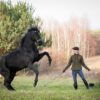I receive a tremendous amount of messages from those of you who struggle with horses that are hyper-active or misbehaving when clicker trained or reinforced with food. Some of you claimed that your horses are crowding you or nipping you, and you simply don’t know what to do.
This is a very common problem when starting training based on a positive reinforcement.
In response to those queries I decided to share with you this short video taken from my upcoming START-UP GROUNDWORK Online Workshop.
First of all – CALM DOWN.
This is absolutely normal that your horse becomes ACTIVE and wants to PRESENT behaviours and TAKE ACTONS in response to training based on a positive reinforcement. Later on we will greatly profit from this outcome, and you will LOVE that your horses are that WILLING and ACTIVE.
My technique is to start teaching my horses to control themselves and their emotions first, before any further training starts.
When you mark behaviours with a clicker, you mark not only the behaviours that you can see, but also the emotions that sometimes are not that easily visible. This is very crucial to reinforce with food your horse ONLY WHEN HE IS REALLY CALM and WITH YOU. Skipping that phase can result in a hyper-active wanting to present behaviours horse which can become dangerous to himself and humans around him when in a BUFFET phase. The Buffet phase is a relatively short but intensive phase in which your clicker-trained or positively reinforced animal decides to take food from you whenever he wants. This is because he is not connecting actions with their outcomes yet, and is focused mainly on GETTING THE FOOD NOW ;-) This may also mean that the horse has general problems with controlling himself, and we have to keep that information in mind during further training.
“Don’t do it” cue means that you have to give up on rewarding yourself, and WAIT for the trainer to reward you or decide what to do next.
Teaching this cue from the scratch is a part of our “From CALMNESS to COMMUNICATION” Module from my upcoming Start-Up GroundWork Online Workshop.
Later, you can use this command anytime you want your horse to stop doing what he does. May it be presenting pesades under the saddle (which you happily trained him to do from the ground before, but you are not happy to have them presented when mounted just right now), or simply when your horse is getting too close to you, or starts to be obsessed with treats and stops to think and to really be with you.
Here you can also watch me introducing this fantastic Cue to my 1,5yo stallion:
GOOD LUCK!


I love the focus on consistency, It is one of the most important aspects of approaching training, Thank you for the pointers!
Anybody who has a horse knows that patience and consistency are the two main keys to success with them. It takes a very patient person to train a horse. Bless you for being one of them. :)
Very true about the need for both rider and horse to control their emotions. Staying calm is indeed the best thing for both. Calm leads to calm, and stress leads to stress. That’s what we also teach each of the new horse owners who adopt from our rescue.